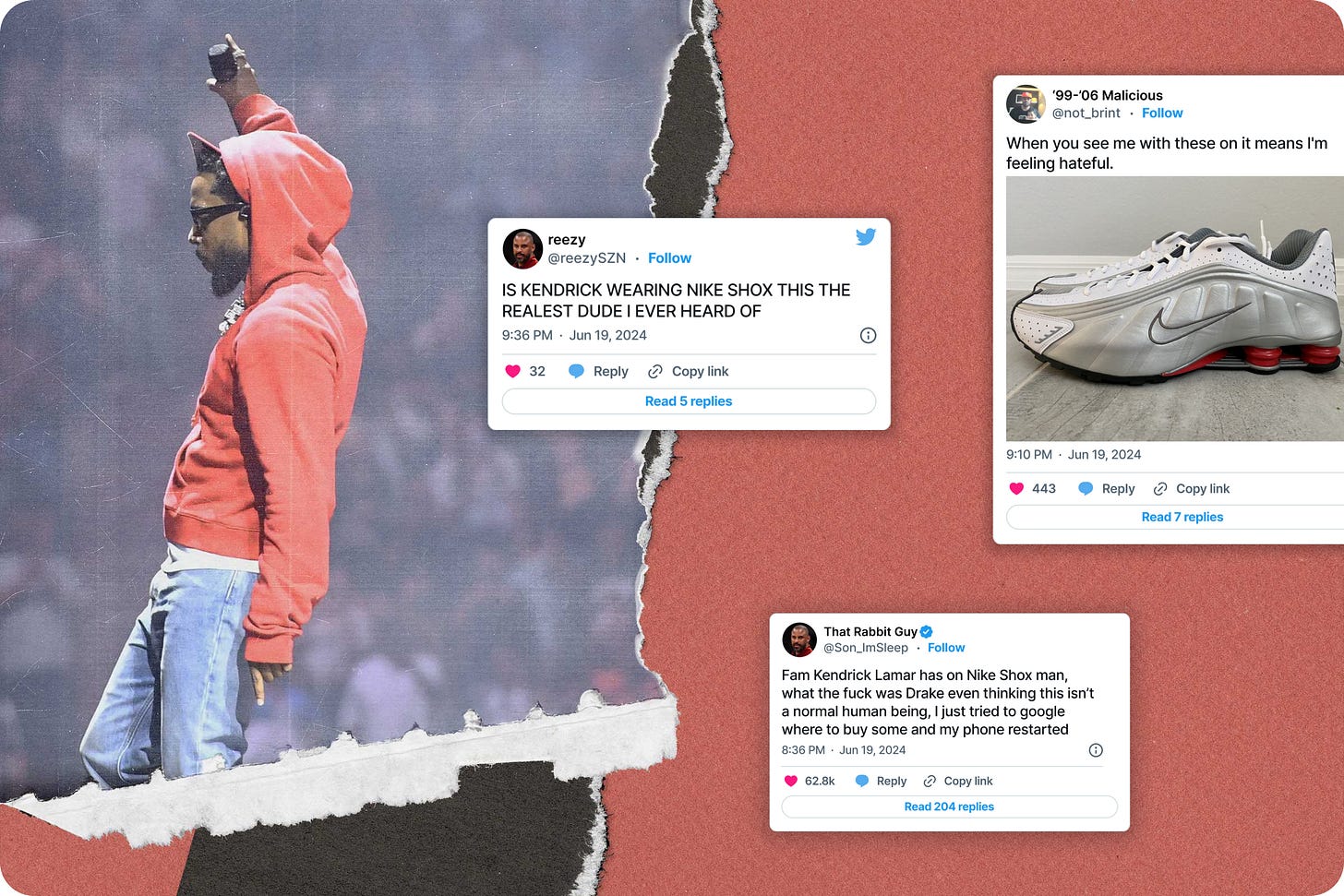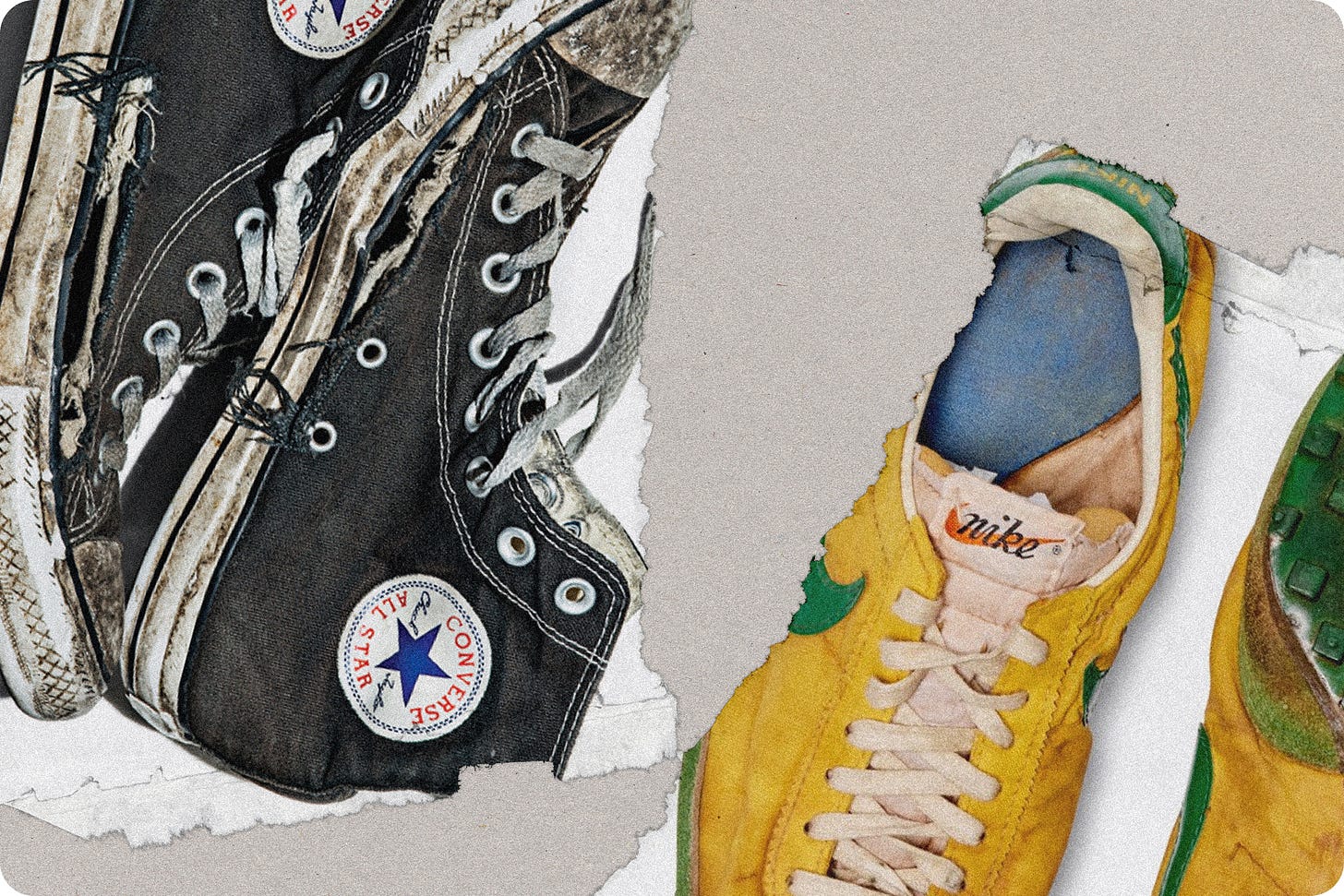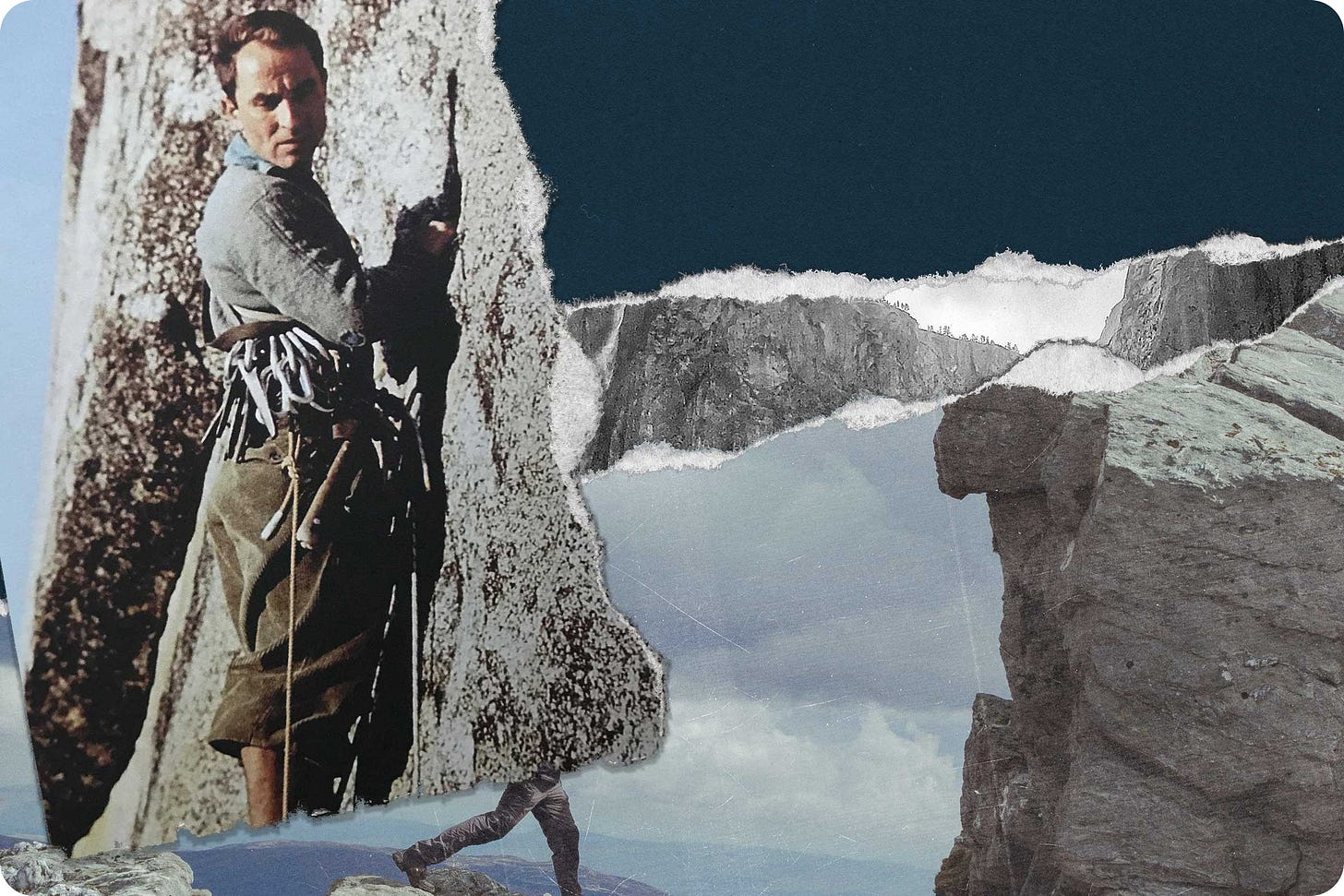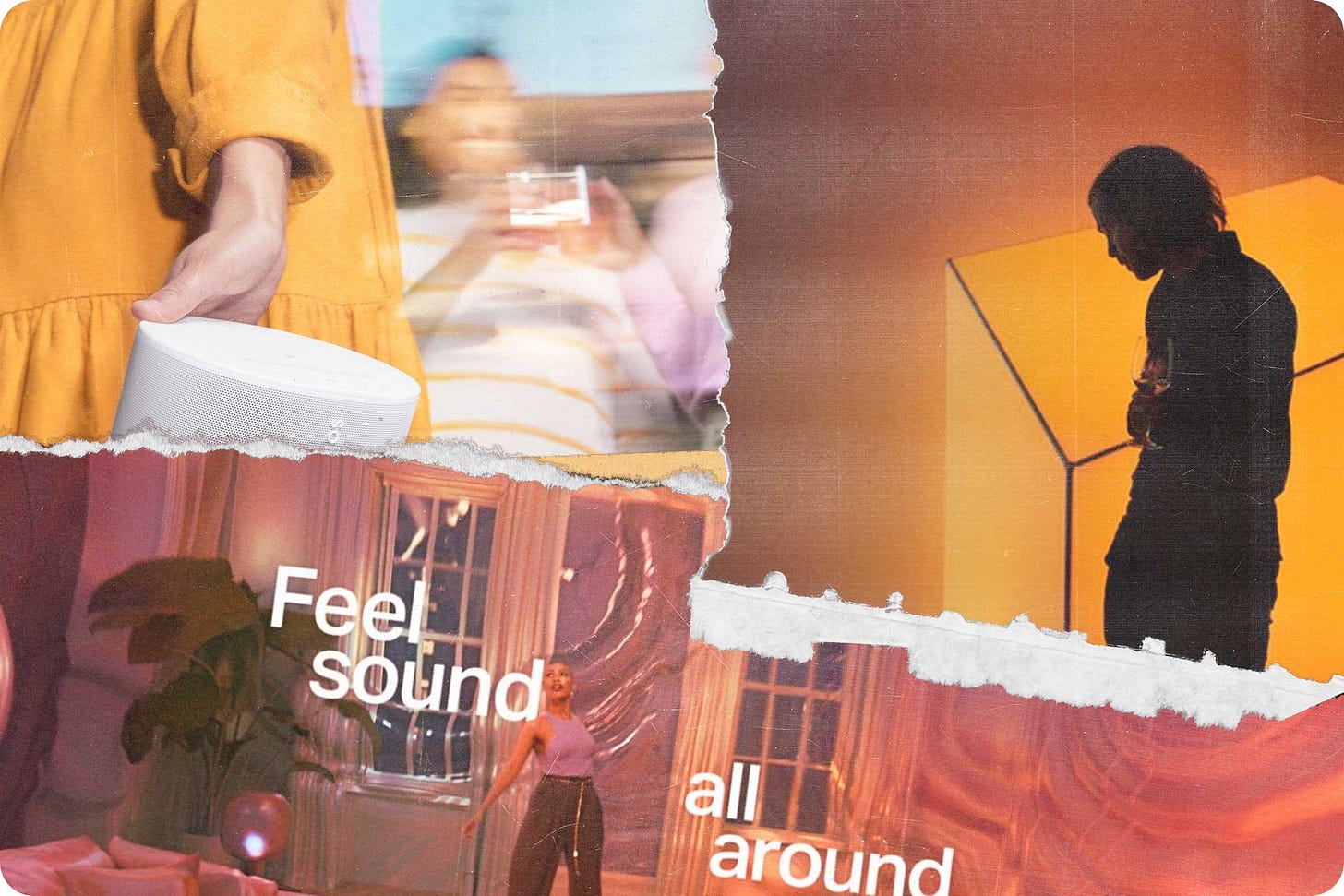Somewhere on Earth, someone in a band is wearing Chucks onstage right now. They’re kicking on their overdrive or cradling an earpiece against their shoulder as they queue up the next track. The concentration of Chucks within any given scene or genre may wax or wane but they are always there and have been for decades.
Shift the scene, and the same goes for Nike, except now we’re talking about athletic events. Someone is always going to be wearing the latest carbon-plated shoe or whatever promises the best energy return through the sole. When Kendrick Lamar hosted The Pop Out: Ken and Friends in a pair of OG colorway Nike Shox R4s — advanced yet deeply uncool technology from the turn of the millennium — it was a record scratch because the contextual clash was jarring.
“These are two very different brands, and remember, Converse is owned by Nike,” says Joy Howard, who served as Converse’s vice president for marketing from 2010–13. “Living the Nike brand means you get up early in the morning and you go running. You do competitive sports. And living the Converse brand means you stay up late drinking. You go to shows. You wear Chucks to work. You're hungover the next day, but that is part of living the culture of the brand.”
On one level, this seems wild — we’re talking about shoes, after all. Many, many people who own Chucks also own Zoom Airs. But we also intuitively understand that these brands exist in different cultural contexts, and that the connection to those contexts was not created strictly through the measured steps of a traditional marketing plan.
“When you're doing that sort of incremental work, the best metaphor for me is that it's like being in the boiler room of a boat that's coal powered,” says Howard. “And the team is shoveling coal into the boiler and you’re doing it, and shoveling it really hard, right? And you're getting some growth out because the boat’s going forward.”
“[But] when the brand really hits in culture,” she continues, “it's like you raise the sail and the sail fills with wind. And that wind is the trends that are happening in culture, the desires that people have. They want to talk about the role that you play, and they fill that sail with wind, and it goes fast.”
There are without a doubt elements of timing, fortune, opportunity, and plain old luck involved in this kind of approach. Be they winds for sailors, waves for surfers, or culture for brands, the movements of massive, complicated systems won’t be tamed. But with perception, planning, and patience you can harness them.
“Unfortunately, there's a big narrative that brand is expensive, and it takes a long time. I think that's the case if it's not really very effective. This is definitely the fastest path to grow. This is, for sure, the most fun,” says Howard. “It's also the scariest.”
CONVERSE & LIVING THE BRAND
Joy Howard’s first time riding a cultural wave came well before her experience leading branding and marketing for companies like Converse, Patagonia, and Sonos. In her twenties, she was the bassist for Atlanta shoegaze band Seely, who became the first American band to sign with British label Too Pure — the first home of PJ Harvey — in the wake of the alternative explosion set off by Nirvana and grunge.
“This was a chapter of my career I thought would never have anything to do with my professional life, and it turned out to be absolutely crucial,” says Howard. When Seely broke up in 2000, she went to business school and then into the world of consumer packaged goods (CPG) and marketing, first at Johnson&Johnson and then Coca Cola. But something was off.
“I had a lot of frustration with innovation working in the CPG space,'“ she says. “I always felt like there were other brands that were taking us by surprise and coming out of nowhere. And even though I really enjoyed learning about the innovation process in CPG companies, I always had this nagging feeling that there was something missing that would explain why brands would just explode out of nowhere in our competitive space.”
When Nike came calling to see if she would join Converse, her background in music turned out to be a crucial. “They had a very creative CMO and they wanted someone who would bring more strategic, analytical, and commercial rigor to the business, essentially without alienating the cool kids,” Howard says. “That allowed me to get a role within Nike — which is known for building cultural powerhouse brands — and to convince them that I would do that in a way that wasn't destructive to the brand. Because, frankly, so much of the classic CPG marketing models [are] very destructive for cultural brands. I felt like a lot of the innovation that I was doing was focused on mindshare or preying upon people's anxieties and then calling those unmet needs.”
Ten years in CPG marketing taught her that the biggest obstacles to achieving cultural impact for a brand were A.) an approach that focuses on people as individuals without the cultural and social contexts in which they exist and B.) the layers of bureaucracy that stripped the vitality out of ideas and turned the creative approach into an assembly line of siloed brand managers and creatives. At both Nike and Converse, employees embodied and inhabited the brand as part of their everyday lives. By living the brand, they could get into a headspace beyond demographic slices and begin to see culture as both something the brand grew out of and something the brand could cultivate alongside its audiences.
“Very few brands can actually shape culture,” Howard emphasizes. “We like to tell ourselves that story that we're shaping culture. But the reality is that most of the time we're just tapping into something that's already happening. And we're using that wind to fill our sails.”
PATAGONIA & THE BRAND MUSE
With Converse, Howard began to work in cultural branding, and at the core of the cultural branding approach is the brand muse. Instead of an untapped market or a growth target with unmet needs, the brand muse presents as a clear, well-defined persona or character who can serve as a touchstone — a test for determining the genuineness of a thing — for all the activities of a brand.
Howard explains: “The essence of a brand muse is someone who not just inspires you creatively, but also whose story will inspire other people to live their lives in a way that's aspirational to them. For Converse, it was really the core creative, right? People who were in bands. You know, artists, people like that, people who really were unlocking their own creative spirit, and by telling their stories we inspired other people to do the same.”
When she arrived at Patagonia in 2013 as the first head of marketing, the brand muse was even clearer and more specific. It was the company’s founder, Yvon Chouinard. He was an accomplished rock climber, innovated the modern sport of ice climbing, and was a wanderer, a writer, an environmentalist — the quintessential outdoors dirtbag. At that time, the company was growing — but also drifting from the core roots it had set down in the ‘70s and ‘80s.
“They really felt that one of the problems with the business was that so many people were wearing it that they didn't identify with,” says Howard. “They had a Fratagonia problem, right? Like all the frat boys wearing Patagonia. They had a Patagucci problem, right? They don't really admire people who are acquisitive, and kind of live a very materialistic lifestyle.
“The task was to help the company understand what it was about Yvon that mattered today because the things that mattered about him when the brand first popped off in the ‘90s — his life changed, the world changed — it wasn't the same things. So much of his life in the ‘90s that was so inspirational to people had become commodified by other brands.”
It wasn’t, however, about adapting the Brand Muse or adopting a new Brand Muse to fit changing trends. Athletes in the great outdoors — surfing, skiing, climbing mountains — had always been a part of the brand’s identity, and so the first thought was that they needed to go bigger and more extreme because the brand had gotten soft.
“But the reality was they already had people who were working with the brand who are extraordinary athletes, and the reason that they worked with the brand was almost invisible to them,” says Howard. “They all worked with the brand because they were activists, and they all shared a commitment to solving the environmental crisis.”
“The real unlock for Patagonia was to help them understand that Yvon was not just a dirtbag in the ‘90s and [they] needed to keep telling that story. He was the dirtbag activist. There were dirtbag activists in the company right now, working in the company, around the office. Professional athletes or sponsored athletes. They only worked with Patagonia because they really cared about saving the places where they did their sports.”
Getting to the dirtbag activist wasn’t about chasing the new or the novel, but rather approaching a broad and deep understanding of the company from a different vantage point. “The discovery of a Brand Muse always comes very specifically from the context of that brand,” says Howard. “From its business challenges, to the growth that it’s trying to unlock. It comes from the genealogy of the brand. It's really important to understand the history of the brand, and it does not require a genius founder.”
SONOS & THE HUMAN TRUTH
When Howard landed at Sonos in 2015, the roughly decade-old company was still young, especially compared to Converse and Patagonia. They also had a product created by deeply tech-y people through robust tech innovations that could not matter less to the consumers who would reap the benefits of having music spread effortlessly through their homes. Founder John McFarlane did not cut the kind of aspirational figure that Chouinard did.
“I was inspired by the founder,” says Howard. “But he was the kind of person that you would put in front of a camera, and nobody would understand a word he was saying.”
This extended to the brand’s early adopters. If Converse’s were punks seeking out cheap kicks and Nike’s were committed long-distance runners, Sonos’ early adopters were your somewhat awkward neighbor gushing about their $10k stereo system when all you needed was a cup of flour.
“We had to do a lot of digging to understand: What's the muse for the next wave of growth? We needed to really understand what was special about the product experience that could be special for other people and relevant today,” she says. “And that was the product's ability to transform your experience of being at home, to transform the feeling of being at home.”
The core insight they came to was something they called “the adult fade.” It describes the way that music is so powerful and so essential to us as teenagers because our emotions are right at the surface, constantly on the verge of boiling over. Then as you grow up, its significance in your life starts to fade. Yet we all long for that time when music hit us so hard.
“Researchers have uncovered evidence that suggests our brains bind us to the music we heard as teenagers more tightly than anything we’ll hear as adults,” writes Mark Joseph Stern at Slate. “Musical nostalgia, in other words, isn’t just a cultural phenomenon: It’s a neuronic command. And no matter how sophisticated our tastes might otherwise grow to be, our brains may stay jammed on those songs we obsessed over during the high drama of adolescence.”
This insight got Sonos to a human truth — an observation or idea that strikes a chord that can resonate with shared human experience — but they also had to push it beyond an emotional space.
“You could take that insight and go straight into not-cultural, CPG land, right? You could go straight into, well, the benefit of Sonos is music. So hooray music,” deadpans Howard. “But the product disappears from that experience. So the product has to play a role that really matters in culture, and also matters to the people who live in culture.”
“We discovered that when people would fill their home with music, they would be less anxious. They would tell each other that they loved each other more. Kids would be less grumpy about helping with chores. The whole experience of being in the home would change when you were playing music.”
Tightly connecting the emotional and space-transforming benefits of music with Sonos’ ability to provide that in a way that simply works without having to learn about the technology is an approach that, in retrospect, feels simply intuitive and correct. But getting there is neither strictly magical, nor strictly a matter of following steps. Like a good pop song, it lives in the gaps between what we already know, showing us new ways to understand what’s around us all the time.
“The work of cultural branding is iterative,” says Howard. “It takes time. It takes a lot of experimentation. People who are working on it need to be protected because in some ways it's like a flame that you're trying to ignite and light up. When you see it start to work, you start to see other forces and culture helping you do the work.”
Iterative approaches demand a certain level of trust and understanding, both within a team and within a company. They can work quickly and dynamically because the world is shifting more or less constantly, but they also require commitment to the experiment. You have to keep your head up, which is exactly what appealed to Howard.
“As soon as I learned about how cultural brands disrupt established categories, I was hooked,” she says. “I think a part of why I responded to that so much is that I really care about the wider world. I care about culture. I care about people. What I like to do is depth ethnographies where you really listen to people talk about their lives.”
That engagement with the world — with culture, with people and their messy, often unbucketable lives — is what continues to drive Howard today as someone who, as she puts it, “builds the brands that other brands want to be.” The through-line, stretching back even to her days in music, is the reaching for connection, that hope of making some sense — even if it’s temporary — of where we find ourselves today, and building something with that understanding to get us to tomorrow.
You’re not looking for the wind or the wave that will last forever. You’re looking for the one that will get you to the next one and the next.









